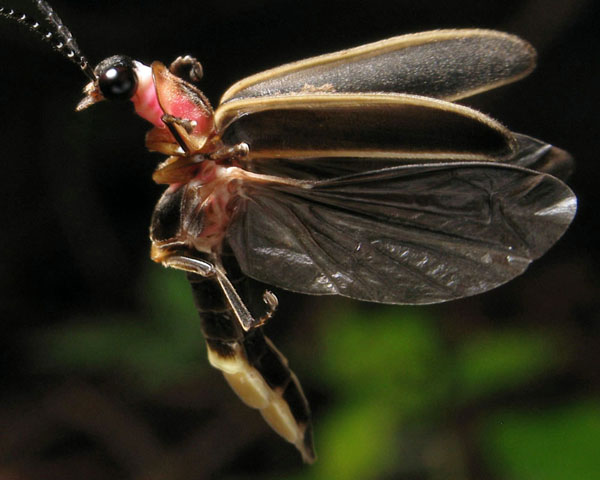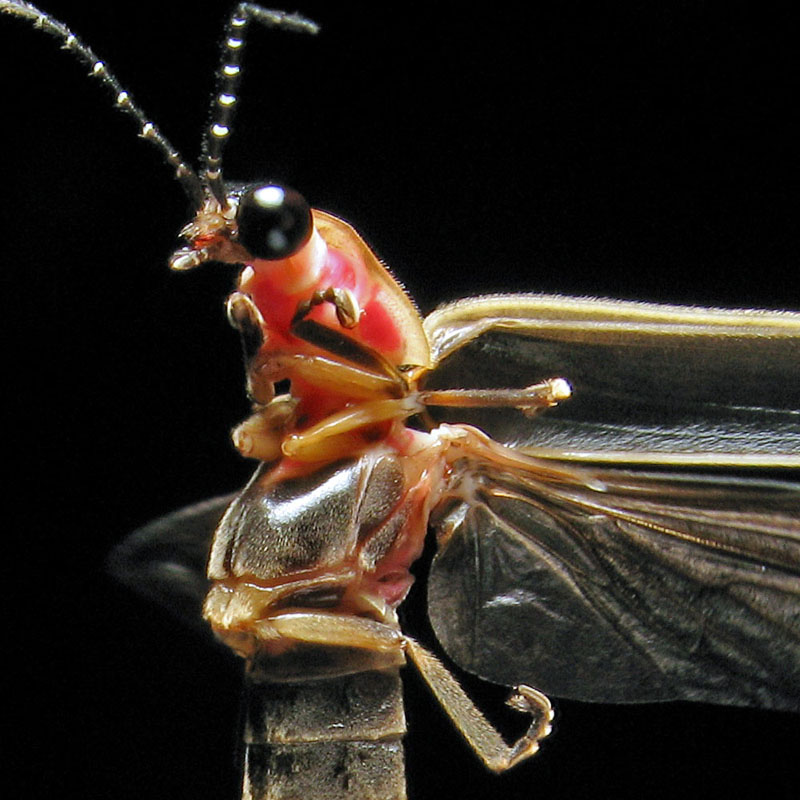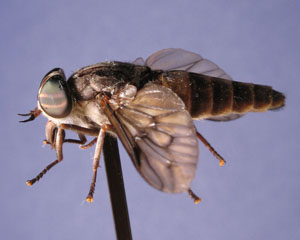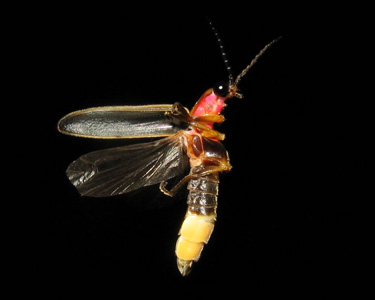Photographing the Common Eastern (USA) Firefly - (Photinus pyralis)

What makes the firefly so unique, his mating flash, also makes him a bug photographer's dream. He pauses right after the flash. I cannot say if this will work with other species. Photinus Pyralis is the most common firefly (so I read) in the world. It's native to a large portion of eastern and midwestern United States. As an adult, it lives only a few weeks, and only the males fly. The females wait near the ground, on a bush or a leaf. They communicate with light. The males fly and flash, then pause, maybe they are re-charging, but I think they are watching for an answering flash. It's a predictable pattern, and you can time your photo, for their flash is the cue. The males flash about every 7 seconds. When a female answers, its about 2 seconds later, just as he stops to look.
You don't need a great camera. In fact you need a camera with all-manual controls. Especially the focus must be a fixed focus. You are going to bring the camera up to the bug when he is hovering and take his picture. Everything has to be set before you do that. You are not going to frame the picture on the lcd or the viewfinder. You point the camera at the bug. You visually memorize how far in front of the lens the firefly should be. He is moving, he is a half inch tall, and its getting dark. You are going to miss a lot of pictures, but there are thousands of fireflies out there, and you have instant feedback. Set the picture review for about 2 seconds. If you are always high or always low, or if you are always fuzzy, are you too close or too far away? On a good night in the peak of the season, you can take a lot of pictures. This would never have been practical with film.

The first summer I stumbled on to taking pictures of fireflies, 2006, I had a Canon A80. It was a nice camera, but nothing special, a 4 mp point and shoot. What it had was a manual control mode, and the ability to focus two inches in front of the lens. If the manual focus and the bug are in the same place, if the flash and exposure are set so he is not a white blob - you have a picture.
Your settings will vary of course. Part of the fun is looking at the pictures on the computer to see what you have, then going back out and making adjustments. It's a great way to learn how to use your camera to take close-up pictures. There are other bugs out there in the dusk, and even during the day you can use the same setup for fill-in flash.

Camera Keys:
Manual focus, camera flash and settings designed not to overexpose the picture.
The camera flash is going to freeze the motion. (To avoid confusion,
I am going to refer to the camera flash and the firefly glow.) Set the
shutter speed to the fastest flash sync. Set the aperture to the largest
number, to get the greatest depth of field. Usually with cheaper cameras
at macro distances, the camera flash will overwhelm the subject. The Canon
had a simple 1-2-3 flash strength in manual mode. Set it to the weakest
flash. Set the ISO number (sensitivity of the "film") to the
smallest number. Set the white balance (this is more of a refinement)
to flash or cloudy. For the A80 then (and the G7 is not much different)
, practically every setting was set to its max or lowest setting. If your
camera is not quite so designed, say the flash is just too strong, you
could cover it with a piece of bubble wrap or wax paper.
- All manual camera controls
- Shutter = 1/500
- Aperture = f8.0
- ISO = 50
- Flash = weak

Those first pictures were taken with a fixed focus at 2 inches in front of the lens, because that was the minimum that camera would do, so that is where I set it. This year (2009) I set the Canon G7 to a focus about 2.75" in front of the lens, and increased the zoom to 2X. You have to experiment with distances and zooms. The bugs are less skittish the farther away you are. Set your camera up on your desktop and take pictures of something about a half inch long (a firefly is about as big as a penny) 2-3 inches in front of the lens. You will come back to this because this is the crucial setup - setting, saving and then visually memorizing exactly where the fixed focus is in front of the camera. Draw a square about 1.5" x 2", set it about 2-3" in front of the lens, make sure you can focus on it, lock in the fixed manual focus (and all the exposure settings) with one of your save setting buttons.
Picture Technique Keys:
- Point the camera with your hands. Don't look thru the viewfinder. Look at the barrel of the lens, position it the right distance from the flying bug, and point it.
- Hold the camera in both hands
- No shutter lag - half depress button in advance
- The camera does not have to be vertical or horizontal - rotate and crop your pictures. Notice their flight posture (angle) so you can rotate your pictures accurately.
Cut a popsicle stick (or any stick) from the base of the camera to the focus point. Carry it with you. Or tape a piece of thin cardboard or string to the bottom of the camera and cut it off at the focus point. I took pictures of rulers and book edges on a tabletop to make sure my guide and the camera were in sync. Go outside and find a weed and use the popsicle stick to position the camera. Start taking pictures. Visually memorize the distance in front of the lens to the plane of focus. Use the guide to train your eye. One of the best aids I eventually found, the focus point was twice the barrel distance. I could see that. The barrel was 1.375" in front of the body of the camera, the focus point was twice that in front of the lens. It's difficult, but so is hitting jumpshots, driving a stickshift, typing, doing taxes. This is the key to success, knowing where the focus is. If you don't really know, you may get an occasional good picture, but not very often. But don't worry, there is no substitute for practice.

*You have to be able to see them to photograph them. The firefly lights up a fraction of a second, some more than others. Its too dark when all you can see is their glow. Be ready for the first ones of the evening.
* Watch the flight pattern. They hover, fly off, glow, and hover. Get ready on the glow, take on the hover. Each firefly flies a little differently, look for a stable one. The big ones fly a stable pattern, the little ones are jumpy. You can tell a little one from a big one by the length and strength of its glow.
* The firefly flies in an inverted hoop, up and over. As he is sinking, he suddenly shoots up. They fire on the way up, pretty much during their maximum acceleration, that's why it is so hard to get a picture of them during their glow. Just after his glow, he pauses a brief second. He is looking for an answering flash (and to take his place in the wheel of life). He seems to tolerate his picture being taken at that moment. I usually don't move toward them too much during their pause. They also don't like to be breathed on, or have sticks broken right under them. Of course I don't wear bug repellent. That would just be silly.
* Track them, bringing the camera closer. Watch a few cycles. Notice the pause after the glow. During the glow, stay outside his circle of fear (about 6-10 inches), then bring the camera up for a quick no-lag click on his pause. Here is something it took me quite a while to realize. Approach them from behind. Bring the camera up behind them to the right distance, then slip it around to his side. If you bring the camera up from his side, he can see that motion and shies away from it.

* The depth of field is not very wide at this range. Most of your best photos with the entire insect in focus will come with the firefly's body parallel to the lens.
* Half-depress the shutter button as soon as you start tracking one. You want as little shutter lag as possible to throw off your timing. You don't have time to compose the picture thru the viewfinder, or allow the camera to calculate focus or exposure.
* After you master everything else, the hardest part is bringing the camera up to exactly the focus plane, hold it still, and get an in-focus shot. You will also point it off center, but just keep watching the barrel.

After Year One, the improvement I most wanted was an external flash that I could point down. This made for a much more natural and adjustable light. I bought a 10 mp Canon G7, stepping up from the 4 mp A80. At first I thought the pictures were harder to focus, but that was just because there was more pixels. In reality, the pictures showed much more detail. The flash was a 30 year old Sunpak made for Nikon that my dad had. I used it in manual mode. Even on the weakest setting, it was a tad strong. I made a reflector hood and covered it with a soft white cloth I bought at a craft store (I think its called chiffon). I put some bubble wrap under the cloth to further diffuse the light. Sometimes I would remake it with more or less diffusion, depending on what I was seeing in my pictures.

firefly 2679, taken summer 2007 with Canon G7 10 mp.
Sneak up from behind the bugs. They can see motion from the side.
I wore long pants, a long sleeve shirt. In June when the biting flies were out, I pinned a hand cloth to my hat to hang over my neck. I carried another cloth in my back pocket to wipe sweat and swing at the flies. I would consider wearing gloves if I could find some that didn't bother me. The mosquitoes love the hands.
Don't be fooled by the LCD display. Mine has an auto-bright feature in the dark. The pictures on the computer were always darker.
Once you master the basic technique, lighting and posing become the issues. You always need light on his head, but not the back of his head. The basic shot is from the side. He tolerates that, you can gauge the distance. With his body parallel to the lens, you have the best chance for body and wings to be in focus.

After you get a shot square from the side, try angling the camera a little up or down, or with the camera rotated slightly to his front. The position of the flash is very important. I use freshly recharged batteries each night for consistency. I think my old flash unit takes more than 7 seconds to fully recharge.

With lighting, the more ambient or reflected light the better. Get him in front of a tree, or with reflective leaves, or even against the ground. Background vegetation always looks good, it puts you in his world.


When they don't like you, when you disrupt their pattern, they run away. They do not like being flashed from the front. If you flash from the side, many of them don't seem to mind, they stay in their normal pattern, and you can get more than one shot. If you slip the camera around to his front, in his line of sight, he will probably run away after (or before) one picture. Just watch them, don't try to take a picture if you are not ready. You are not likely to get a good picture by jabbing the camera at him. You get a good picture by observing him - they do not all fly the same - by not scaring him, and anticipating his pause.
The big desire is to take a picture while they are glowing and flying. Its possible but difficult. I think it really annoys them and is frustrating to the picture taker as well because it is largely a matter of luck. I did it once, most obviously, in 2006.


Are we torturing the insect? Are we interfering with his mating? Maybe a little. There are about 100 males for every female, wild estimate. I think we do far more harm to them by bug sprays, yard sprays, and probably even driving to the store at dusk, than we will ever do by photographing them and showing what graceful creatures they are. I have never killed one and mounted it on a pin for practice, more than I can say for those damn flies!

These things will draw blood and bite through a denim shirt. This one got in the house. Notice how he is lit underneath. I tested my bottom reflector on him.

The firefly season around here starts near the beginning of June and begins to thin considerably about the middle of July. During the peak days, when they come out with the most ambient light, you will be able to take over a hundred pictures. You may only get one picture out of a hundred, or when you get good, you may save a third. If you get just one great shot, you will probably be out there the next evening watching the darker areas of your yard, garden or forest for the first golden yellow flash. Get out early. The easiest and prettiest shots are with the most background light. Fireflies are part of the best days of summer, when you can afford to waste time and have some fun. Good luck.
copyright 2009 Terry Priest, all rights reserved
I have gotten several requests to use firefly pictures in various publications,
I have never said no, just ask. There are also
5 images with Wiki Commons Rights, you can use without permission but need to maintain the attribution and flickr link.
tx.priest@gmail.com
www.frfly.com


















